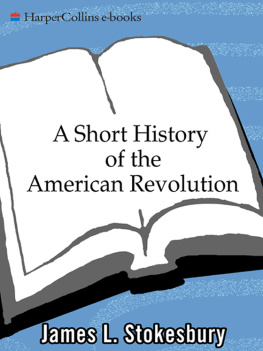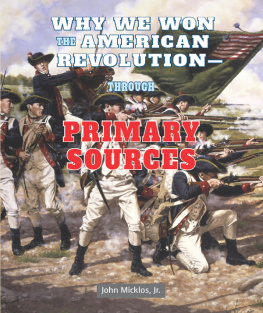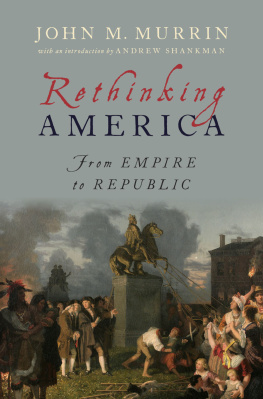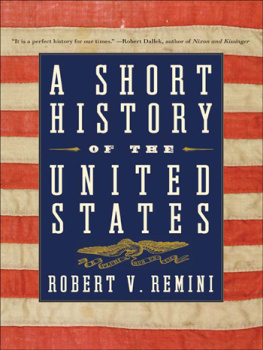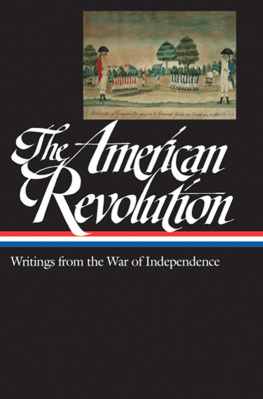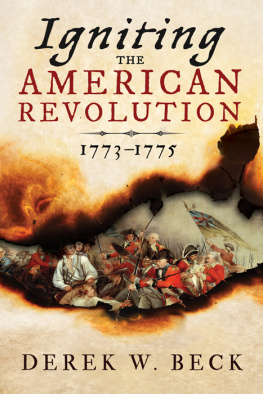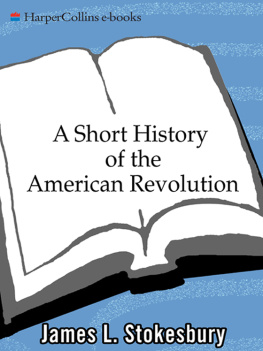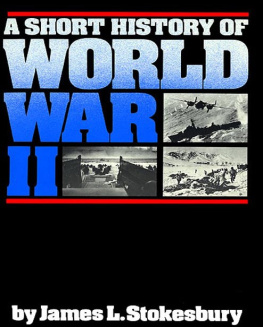James L. Stokesbury
B OSTON LAY quiet under an early spring night. But the stillness of spring evenings is illusory, as anyone who lives in the country knows, and in fact the small city was teeming with activity. Lieutenant General Thomas Gage, commander in chief of His Majestys forces in North America and governor of Massachusetts, had serious business in hand. He had recently received peremptory orders from London; the government at home, finally out of patience with recalcitrant colonials, had ordered Gage to take some decisive action which would reassert royal authority. Gage had decided that the appropriate gesture was to seize military stores the colonials were known to be amassing at the little village of Concord, several miles west of Boston.
To do this he detached sixteen flank companieseight of grenadiers and eight of light infantryfrom their regular regiments, and put them together as a striking force under the command of Lieutenant Colonel Francis Smith of the 10th Foot. At dusk on April 18, 1775, these troops mustered on Boston Common, approximately seven hundred strong, and at full dark they set out on their mission. Boats from the Royal Navys ships in the harbor took them across to Lechmere Point, on the mainland, where, in the time-honored fashion of military forces, they waited a full two hours for additional rations they did not need before setting out on their march to the west.
In spite of all their precautions, the British were not the only ones awake and about in the night. Just as the countryside was full of loyal subjects who had informed Gage of the presence of stores and colonial leaders in the towns outside Boston, so the capital was full of men who were no friends of the British; a casual word here, a dropped hint there, had been enough for the opposition to have a very good idea of what was going on. The British were closely checked and their moves signaled to watchers across the Charles River and Back Bay. Dr. Joseph Warren in the city had sent William Dawes and Paul Revere out with the warning of British action. Between the two of them, they roused the countryside out as far as Lexington. Revere was later captured by a mounted British patrol, officers sent out along the roads to prevent exactly this sort of thing, but by then his work had been taken up by other riders.
Meanwhile, Colonel Smith and his men plodded along, increasingly aware that they were not alone. At Menotomy, a little more than halfway out to Lexington, Smith halted his troops and called an officers conference. He decided they were not moving quickly enough, and therefore detached an advance force, commanded by Major John Pitcairn of the Royal Marines. Giving the major six companies of the light infantry, he told him to push ahead and seize control of the bridges at Concord. As the light infantry swung off down the road, Smith also sent a rider back to Boston asking for reinforcements.
Paul Revere had reached Lexington at midnight, while the British were still clambering out of their boats at Lechmere Point. He found there two of the most outspoken Patriot leaders, Samuel Adams and John Hancock, both of Boston; they were finally persuaded to leave, to avoid arrest, about midway through the early morning hours. The commander of the local militia force, Captain John Parker, mustered about 130 men and awaited further developments. He sent several scouts east along the road to Boston, but most of them did not return, and eventually Parker dismissed his company, telling the men to be ready for further action. Many of them drifted off to Buckman Tavern, the only place to keep warm in the cool April night when sensible men were tucked up in their beds.
Parkers scouts failed to return because most of them were scooped up by the point of Pitcairns advance. Finally one of them, Thaddeus Brown, came in about first light to report that he had just evaded the British, who were only half a mile behind him. Parker hastily recalled his men, but less than half were there on the green, in a ragged line, when Pitcairn led his column into town. The sun was just rising in the east, and the British quickly swung from their marching formation into line. Pitcairn advanced across the green, apparently intending to disarm the American force, which he outnumbered perhaps five to one. Parker, with eminent good sense, was on the point of deciding to withdraw. At that point, a shot rang out, then several more, then a volley from the British, and a smattering of return fire from the Americans. The redcoats charged with the bayonet, the militia broke, and within a couple of minutes it was over. Eight Americans were dead, ten wounded; one British soldier was shot in the leg, and Pitcairns horse, a better target, had two slight wounds.
By the time Pitcairn had restored some sort of order, Smith and the remainder of the column arrived, and the British soon resumed their march to Concord. They arrived there about seven, to find again that the local militia had turned out. While the grenadiers searched for stores, most of which had already been removed, the light infantry went forward to hold the bridges over the Concord River against interference. At the North Bridge, several hundred militia advanced against three British companies, and this time, having already been blooded at Lexington, there was no hesitation among the redcoats. They opened fire as soon as the Americans came within range, and after a short but spirited exchange, they then fell back into town.
Smith had now done all that it seemed he could, so he began his return march to Boston about noon. By now everyone felt that it had been a pretty sorry days work, but few could realize how much worse it was to become. About a mile back down the road from Concord, at Meriams Farm, the British were ambushed by American militia companies who had swung around from the North Bridge. Now from all the towns that flanked the British route the militia had mustered, and the British were forced to run a gauntlet all the way back to Boston.
Wherever the ground offered any sort of cover, the Americans came up singly or in small groups and fired on the British column. Smith sent out patrols of light infantry to keep the Americans at a distance, and many were killed when taken unawares. But equally many, operating in their own loose, undisciplined way, filtered in close enough for shots at the redcoats. It was near midafternoon when the head of the column reached Lexington.
Here the British encountered at last their supporting force, commanded by Earl Percy. About fourteen hundred strong, this unit had left Boston at nine in the morning; even before Smiths request for reinforcements arrived, Gage had directed such a movement for 4:30, but orders had been mislaid or not delivered, so Percy was a good five hours behind schedule. His arrival probably saved the original column from annihilation, and he took over command from Smith, who had already been wounded.
The British left Lexington soon after three, and reached Charlestown Neck as the day was ending. All along the way they were attacked by ever-increasing militia arrivals, from Framingham and Sudbury, Danvers and Woburn. The fighting became nastier as the British, frustrated and enraged, burned houses sheltering snipers, and shot or bayoneted anyone in arms they were able to catch.
By the night of April 19, the stars had altered in their courses. A political disagreement among members of the same family had become instead a blood feud. Things could never be the same again. The word of fighting was running like flashes of lightning through New England; while Percys men were still being harried back to Boston, militia were turning out as far away as New Hampshire and Connecticut, and overnight little groups of men, the genesis of squads and companies, were stuffing rations in pockets, filling ammunition pouches, kissing wives good-bye for the indefinite future, and coalescing on the roads to Boston. It was an astounding display of the militias ability to respond to a local crisis, a display that has haunted American military preconceptions ever since. By the morning of April 20, Boston was effectively besieged.

